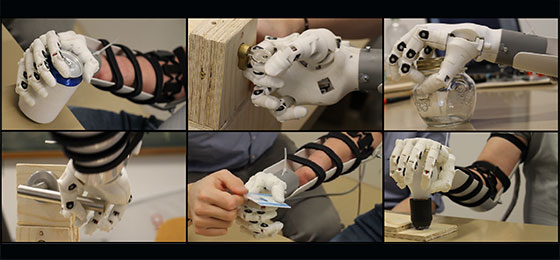Eye-tracking data improves prosthetic hands

Everyday movements were recorded to populate a dataset. © snsf, source: Henning Müller
The hand is a precious limb. Its 34 muscles and 20 joints enable movements of great precision and complexity which are essential for interacting with the environment and with others on a daily basis. Hand amputation thus has severe physical and psychological repercussions on a person’s life.
Myoelectric prosthetic hands, which work by recording electrical muscle signals on the skin, allow amputees to regain some lost function. But dexterity is often limited and the variability of the electrical signals from the forearm alone makes the prosthetics sometimes unreliable.
Henning Müller, professor of business informatics, is investigating how combining data from myoelectric signals with other sources of information could lead to better prosthetics.
Müller has now made available to the scientific community a dataset that includes eye tracking and computer vision as well as other information (electromyography and acceleration sensor data).
The results of this work, funded by the Swiss National Science Foundation (SNSF), have just been published in Nature Scientific Data (*).
Leveraging gaze
“Our eyes move constantly in quick movements called saccades. But when you go to grasp an object, your eyes fixate on it for a few hundred milliseconds. Consequently, eye tracking provides valuable information about detecting both the object a person intends to grasp and the possible gestures required”, says Müller, professor at the HES-SO in Sierre and titular professor in the Faculty of Medicine at the University of Geneva.
Moreover, unlike the muscles of the amputated limb, which atrophy and send different myoelectric signals, gaze remains similar. Computer vision – i.e. computer recognition of objects in the field of vision – can also be used together with eye tracking to partially automate prosthetic hands.
In order to link common hand gestures with information from the muscles of the amputated limb and these new data sources, Müller studied 45 people – 15 amputees and 30 able-bodied subjects – in an identical experimental setting.
Each participant had 12 electrodes affixed to their forearm and acceleration sensors on their arm and head. Eye-tracking glasses recorded eye movements while the participants performed 10 common movements for grasping and manipulating various objects, such as picking up a pencil or a fork, or playing with a ball.
The movements were determined in collaboration with the Institute of Physiotherapy at the HES-SO Valais. Computer modelling of the gestures enabled Müller to build up a new multimodal dataset of hand movements comprising different types of data. The dataset includes information not only from the electrodes but also from recordings of forearm acceleration, eye tracking, computer vision and measurements of head movements.
Free access to data
This multidisciplinary study at the HES-SO, the University Hospital of Zurich and the Italian Institute of Technology in Milan was part of the Sinergia programme. “It’s a significant piece of work resulting from two years of data acquisition”, says Müller. “Importantly, we’ve had access to amputees through the University of Padua in Italy.
In Switzerland it’s hard to find large numbers of volunteers for these kinds of studies, and most datasets are thus based on only three to four participants.”
Another advantage of the new dataset is that the sample of amputees is comparable to that of the control group, which was not the case in previous studies. Using this data will make it possible to better understand the consequences of amputation.
The dataset offers prospects for the manufacture of smart myoelectric prosthetic hands. “By integrating the information from eye tracking, we can improve the functionality of the prosthetics and thus the comfort and independence of the amputees”, says Müller.
This important work has now been made freely available to the scientific community. More than a thousand research groups from all over the world have already accessed older versions of the dataset, developed during previous projects.
Encouraging interdisciplinary research
Sinergia is a programme of the Swiss National Science Foundation that promotes interdisciplinary collaboration of two to four groups engaged in pioneering research.
The text of this press release, a download image and further information are available on the website of the Swiss National Science Foundation.
Henning Müller
HES-SO Valais
Technopole 3
3960 Sierre
Phone: + 41 27 606 90 36 / +41 76 516 5002
E-mail: henning.mueller@hevs.ch
(*) M. Cognolato, A. Gijsberts, V. Gregori, G. Saetta, K. Giacomino, A.-G. Mittaz Hager, A. Gigli, D. Faccio, C. Tiengo, F. Bassetto, B. Caputo, P. Brugger, M. Atzori, H. Müller: Gaze, visual, myoelectric, and inertial data of grasps for intelligent prosthetics, Scientific Data (2020).
https://doi.org/10.1038/s41597-020-0380-3
http://www.snf.ch/en/researchinFocus/newsroom/Pages/news-200211-press-release-in…
Media Contact
All latest news from the category: Interdisciplinary Research
News and developments from the field of interdisciplinary research.
Among other topics, you can find stimulating reports and articles related to microsystems, emotions research, futures research and stratospheric research.
Newest articles

NASA: Mystery of life’s handedness deepens
The mystery of why life uses molecules with specific orientations has deepened with a NASA-funded discovery that RNA — a key molecule thought to have potentially held the instructions for…

What are the effects of historic lithium mining on water quality?
Study reveals low levels of common contaminants but high levels of other elements in waters associated with an abandoned lithium mine. Lithium ore and mining waste from a historic lithium…

Quantum-inspired design boosts efficiency of heat-to-electricity conversion
Rice engineers take unconventional route to improving thermophotovoltaic systems. Researchers at Rice University have found a new way to improve a key element of thermophotovoltaic (TPV) systems, which convert heat…



